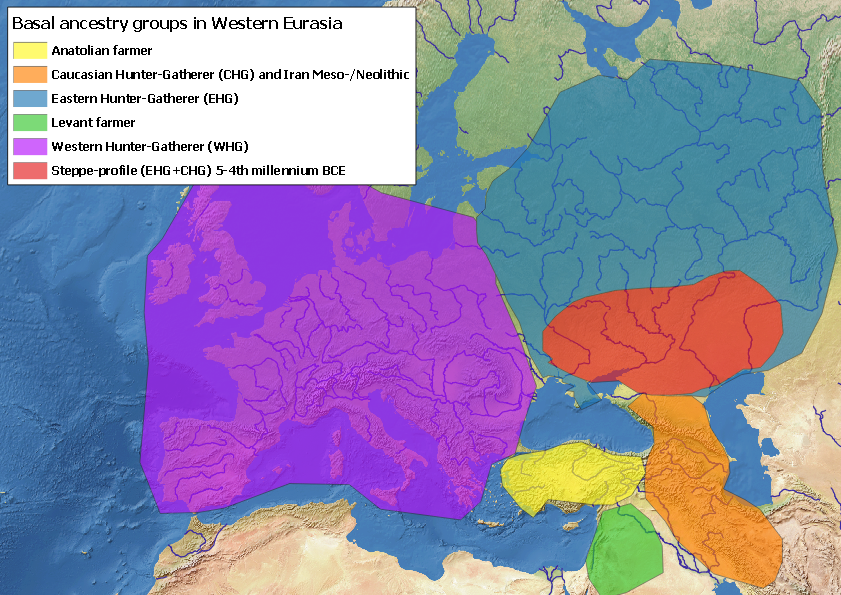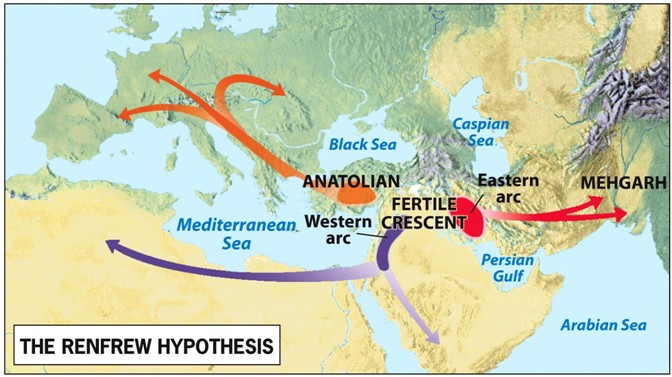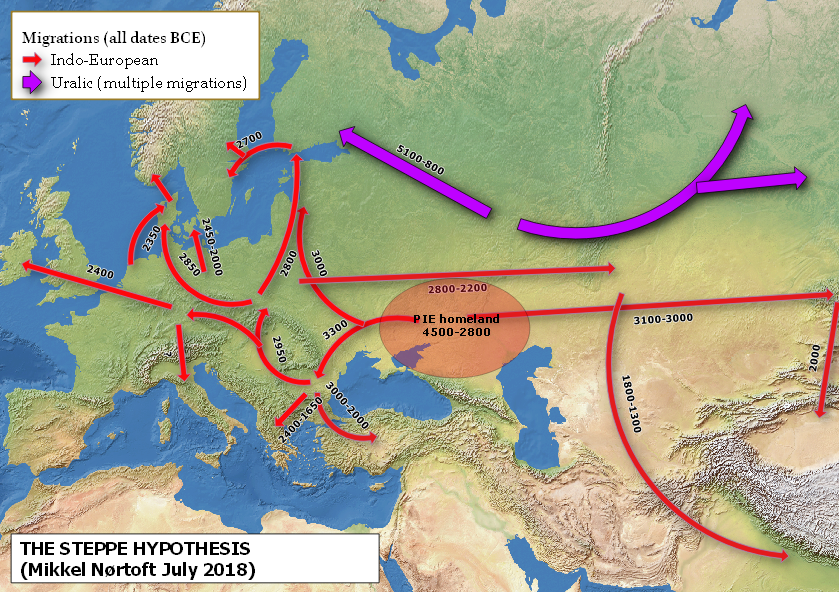[Edit 29 October 2021: Due to accessibility requirements I’ve had to remove the colours; sorry about that. – Thomas]
In this post, we will look into some new findings from the field of ancient DNA which are relevant to the question of the Indo-European homeland. In this first part, we will mostly focus on the genetic aspect, and in the second part (soon to come), we will look at how this can best be correlated with linguistic arguments.
The field of ancient genomics has contributed greatly to the discussion of prehistoric migrations and with that also the discussion of the Indo-European homeland.
Presently, it seems that western Eurasia displays a small number of basal ancestral groups from the earliest sampled individuals going back to the Palaeolithic (colours match the colours on the Homeland Timeline Map and will be used throughout the blog post for readers to better follow which group I am referring to):
– Eastern Hunter-Gatherers (EHG) found in most of Russia and Eastern Europe (including the Pontic-Caspian steppes).
– Western Hunter-Gatherers (WHG) found all over the European peninsula going back to the Paleolithic.
– Caucasian Hunter-Gatherers (CHG) and Mesolithic and Neolithic Iranians which seem to be closely related.
– Anatolian Farmers responsible for the spread of agriculture in most of Europe.
– Levant Farmers going back to the Natufians who are known as the earliest farmers in the Levant.
– The colour RED will be used here for the Pontic-Caspian “Steppe profile” which is a mix of CHG and EHG ancestry. Archaeological cultures related to this Steppe-profile will also be shown with the color RED:

Approximate distribution of basal ancestry groups in Western Eurasia about 10,000 years ago and the later Steppe profile added in red (by Mikkel Nørtoft).
Migrations from the homeland
In 2015, two large (and competing) studies[1] appeared with improved methods looking at the whole genome instead of the earlier methods only using the Y-chromosome (inherited from the father, only in males) or mitochondrial genome (inherited from the mother). Together, they had sampled more than a hundred ancient humans from various periods and regions in western Eurasia.
They reached the same conclusion using two different methods of analysing ancient DNA: the individuals of the archaeological culture termed Yamnaya (or “Pit Grave”) (c. 3300-2800 BCE), and the preceding Khvalynsk culture (5th millennium BCE), both living in the Pontic-Caspian steppes, were genetically closely related to the widespread European Corded Ware culture complex (c. 2900-2200 BCE). They went as far as suggesting a “mass migration” of Yamnaya herders into Europe around 3000-2500 BCE. The Yamnaya genomes were also very close to those of the Afanasievo culture appearing in the Altai region of Siberia around 3300-3100 BCE. The male Y-chromosome haplogroups R1a and R1b spread together with these steppe-populations into Europe and Asia and are still today very frequent in most of Europe. It thus seemed that an exodus of herders moving both east and west from the Pontic-Caspian steppes had now been found in the DNA.
The genetic make-up of Yamnaya
Yamnaya individuals in the Pontic-Caspian steppes also derived about half of their ancestry from earlier local Eastern Hunter-Gatherers (EHG), and about half from the Caucasus region (Caucasian Hunter-Gatherers). This Caucasian ancestry is about 25% in earlier steppe Khvalynsk individuals (5th millennium BCE).[2]
This seems to fit archaeological studies that show movement of material culture from the North Caucasian Maykop and Novosvobodnaya cultures into the steppes during the 4th millennium BCE.[3] The cultural-material evidence of influence from the Caucasus before the 4th millennium BCE is more subtle. It has now been confirmed that the two ancestry groups do not seem to share deep genetic ancestry. Only from the Yamnaya period (3rd millennium BCE), we see the significant steppe ancestry moving south into the Caucasus region.[4]
However, there are a few so-called “outlier” individuals on both sides of this frontier who belong to the other genetic group[5]. This scenario fits the model of cultural contacts between the two groups through small scale movement. Y-chromosome haplogroup J2 (carried by males) is very common in the Caucasian group. Since this haplogroup only rarely shows up in steppe-related individuals, also after the spread of steppe groups, it could indicate that mostly females “switched sides” in a system of patrilocal intermarriage (females move to the husband’s family), perhaps through marriage alliances, or at least that Caucasian male lineages were not very succesful in the steppes. We also see these moving “female brides” in Europe with the arrival of (mostly male) Yamnaya populations forming the Corded Ware phenomenon. This model is further supported by the Caucasian ancestry in the steppes only increasing quite slowly, first to about 25% in the Khvalynsk period (5th millennium BCE), and then to about 50% in the Yamnaya period (late 4th millennium BCE).
Additionally, it should be noted that some minor ancestry in Yamnaya individuals from European Farmers and Western Hunter-Gatherers has also been found recently. This supports archaeological contacts between steppe societies and European farming societies like the Cucuteni-Tripolye town dwellers in Ukraine and Bulgaria and/or the East European Globular Amphora culture where this type of ancestry has been found mixed with European Western-Hunter Gatherer ancestry[4].
In the next post, we will look into the implications of these genetic findings on the question of the Indo-European homeland.
[1] Haak et al. 2015; Allentoft et al. 2015
[2] Allentoft et al 2015
[3] Anthony 2007
[4] Wang et al. 2018 (preprint)
[5] Lazaridis et al. 2016; Jones et al. 2015; Fu et al. 2016; Wang et al. 2018
Literature
Allentoft, M. E. et al. 2015. Population genomics of Bronze Age Eurasia. Nature 522, 167–172.
Anthony, David W. 2007. The horse, the wheel and language. Princeton, NJ: Princeton University Press.
Fu, Q. et al. The genetic history of Ice Age Europe. Nature 534, 200–205.
Haak, W. et al. 2015. Massive migration from the steppe was a source for Indo-European languages in Europe. Nature 522, 207–211.
Jones, E. R. et al. 2015. Upper Palaeolithic genomes reveal deep roots of modern Eurasians. Nat. Commun. 6, 8912 (2015).
Lazaridis, I. et al. 2016. Genomic insights into the origin of farming in the ancient Near East. Nature 536, 419–424.
Wang, C.-C. et al. 2018. The genetic prehistory of the Greater Caucasus (preprint). BioRXiv 16 May.

